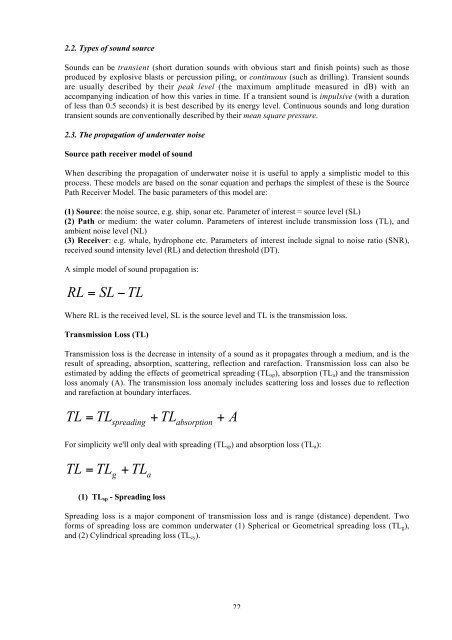Oceans of noise - Whale and Dolphin Conservation Society
Oceans of noise - Whale and Dolphin Conservation Society
Oceans of noise - Whale and Dolphin Conservation Society
- No tags were found...
Create successful ePaper yourself
Turn your PDF publications into a flip-book with our unique Google optimized e-Paper software.
2.2. Types <strong>of</strong> sound sourceSounds can be transient (short duration sounds with obvious start <strong>and</strong> finish points) such as thoseproduced by explosive blasts or percussion piling, or continuous (such as drilling). Transient soundsare usually described by their peak level (the maximum amplitude measured in dB) with anaccompanying indication <strong>of</strong> how this varies in time. If a transient sound is impulsive (with a duration<strong>of</strong> less than 0.5 seconds) it is best described by its energy level. Continuous sounds <strong>and</strong> long durationtransient sounds are conventionally described by their mean square pressure.2.3. The propagation <strong>of</strong> underwater <strong>noise</strong>Source path receiver model <strong>of</strong> soundWhen describing the propagation <strong>of</strong> underwater <strong>noise</strong> it is useful to apply a simplistic model to thisprocess. These models are based on the sonar equation <strong>and</strong> perhaps the simplest <strong>of</strong> these is the SourcePath Receiver Model. The basic parameters <strong>of</strong> this model are:(1) Source: the <strong>noise</strong> source, e.g. ship, sonar etc. Parameter <strong>of</strong> interest = source level (SL)(2) Path or medium: the water column. Parameters <strong>of</strong> interest include transmission loss (TL), <strong>and</strong>ambient <strong>noise</strong> level (NL)(3) Receiver: e.g. whale, hydrophone etc. Parameters <strong>of</strong> interest include signal to <strong>noise</strong> ratio (SNR),received sound intensity level (RL) <strong>and</strong> detection threshold (DT).A simple model <strong>of</strong> sound propagation is:RL=SL − TLWhere RL is the received level, SL is the source level <strong>and</strong> TL is the transmission loss.Transmission Loss (TL)Transmission loss is the decrease in intensity <strong>of</strong> a sound as it propagates through a medium, <strong>and</strong> is theresult <strong>of</strong> spreading, absorption, scattering, reflection <strong>and</strong> rarefaction. Transmission loss can also beestimated by adding the effects <strong>of</strong> geometrical spreading (TL sp ), absorption (TL a ) <strong>and</strong> the transmissionloss anomaly (A). The transmission loss anomaly includes scattering loss <strong>and</strong> losses due to reflection<strong>and</strong> rarefaction at boundary interfaces.TL= TLspreading + TLabsorption+AFor simplicity we'll only deal with spreading (TL sp ) <strong>and</strong> absorption loss (TL a ):TL = TL g+ TL a(1) TL sp - Spreading lossSpreading loss is a major component <strong>of</strong> transmission loss <strong>and</strong> is range (distance) dependent. Tw<strong>of</strong>orms <strong>of</strong> spreading loss are common underwater (1) Spherical or Geometrical spreading loss (TL g ),<strong>and</strong> (2) Cylindrical spreading loss (TL cy ).22




